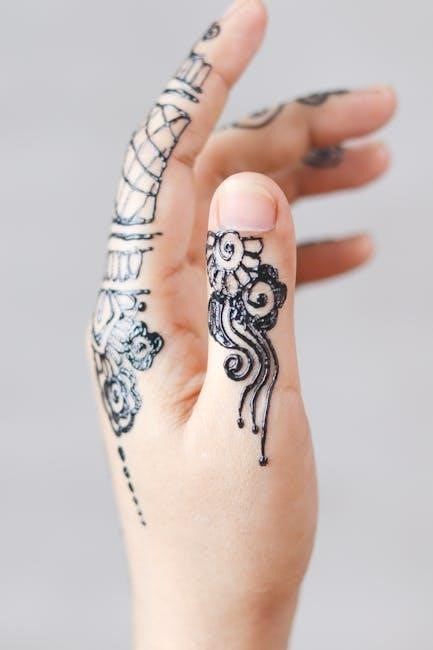The human hand is a complex structure comprising bones, joints, muscles, tendons, nerves, and blood vessels. It enables precise movements, grasping, and dexterity, essential for daily activities and specialized tasks.
1.1 Overview of the Hand Structure
The hand is a intricate anatomical structure composed of 27 bones, including 8 carpal bones in the wrist, 5 metacarpal bones forming the palm, and 14 phalanges in the fingers and thumb. Each finger contains three phalanges (proximal, middle, and distal), while the thumb has only two, allowing for its unique mobility. The hand’s skeletal framework supports a wide range of movements, from fine motor tasks to powerful grasps. The arrangement of bones, joints, and ligaments enables flexibility and precision, making the hand a vital tool for human functionality and expression.
1.2 Importance of Hand Anatomy in Medicine
Understanding hand anatomy is crucial in medicine for diagnosing and treating conditions like carpal tunnel syndrome, trigger finger, and flexor tendon injuries. The complex structure of bones, joints, and ligaments requires precise surgical and therapeutic interventions. Hand anatomy knowledge aids in rehabilitation, enabling patients to regain motor skills and functionality. It also guides the development of orthopedic devices and prosthetics, improving patient outcomes. The intricate relationship between nerves, tendons, and muscles in the hand makes anatomical understanding essential for effective treatment and pain management. Accurate anatomical knowledge ensures optimal surgical precision and rehabilitation strategies, preserving hand function and quality of life.

Skeletal Anatomy of the Hand
The hand’s skeletal framework includes 8 carpal bones in the wrist, 5 metacarpal bones in the palm, and phalanges in the fingers and thumb.
2.1 Wrist Bones (Carpals)
The wrist comprises eight carpal bones arranged in two rows: proximal and distal. The proximal row includes the scaphoid, lunate, triquetrum, and pisiform bones. The distal row consists of the trapezium, trapezoid, capitate, and hamate bones. These bones form the carpus, providing a flexible and stable base for hand movements. The scaphoid bone, the largest carpal bone, plays a crucial role in wrist motion, while the pisiform bone, the smallest, is a sesamoid bone embedded within the flexor carpi ulnaris tendon. Together, the carpal bones allow for a wide range of wrist motions, including flexion, extension, abduction, and adduction.
2.2 Metacarpal Bones
The hand contains five metacarpal bones, each corresponding to a finger and the thumb. These bones form the palm and connect the carpal bones of the wrist to the phalanges of the fingers and thumb. The first metacarpal bone, associated with the thumb, is the most mobile, allowing for opposition and circumduction. The other metacarpals are less mobile but provide stability and leverage for finger movements. Each metacarpal bone articulates with the distal carpal bones proximally and the proximal phalanges distally, forming the metacarpophalangeal joints. These bones are crucial for the structural integrity and functional dexterity of the hand, enabling precise grip and manipulation of objects.
2.3 Phalanges in Fingers and Thumb
The phalanges are small, tubular bones that form the fingers and thumb. Each finger consists of three phalanges—proximal, middle, and distal—allowing for flexion, extension, and precise movements. The thumb, however, has only two phalanges, proximal and distal, which limits its range of motion but enhances its opposition capability. These bones are connected by interphalangeal joints, enabling flexibility and dexterity. The distal phalanges are flattened and support the fingertips, which contain sensory receptors vital for tactile sensation. The alignment and structure of the phalanges allow the fingers to converge, facilitating activities like gripping and writing, making them essential for the hand’s functional abilities.

Muscular Anatomy of the Hand
The hand’s muscular anatomy includes intrinsic and extrinsic muscles. Intrinsic muscles, like the thenar and hypothenar groups, are located within the hand, enabling precise movements and dexterity.
3.1 Thenar Eminence (Thumb Muscles)
The thenar eminence, located at the base of the thumb, comprises muscles essential for thumb movement. It includes the abductor pollicis brevis, flexor pollicis brevis, and opponens pollicis. These muscles attach to the scaphoid, trapezium, and thumb bones, enabling abduction, flexion, and opposition. Innervated by the median nerve, they facilitate precise thumb functions like gripping and pinching, crucial for fine motor activities. The thenar muscles work synergistically with extrinsic muscles to provide the thumb’s remarkable dexterity and mobility.
3.2 Hypothenar Eminence (Little Finger Muscles)

The hypothenar eminence, found on the ulnar side of the hand, consists of muscles controlling the little finger. It includes the abductor digiti minimi, flexor digiti minimi, and opponens digiti minimi. These muscles attach to the hamate and fifth metacarpal bone, facilitating abduction, flexion, and opposition of the little finger. Innervated by the ulnar nerve, they contribute to hand balance and gripping. The hypothenar muscles, like their thenar counterparts, are intrinsic, providing localized movement while coordinating with extrinsic muscles for overall hand function and dexterity in various tasks.
3.3 Intrinsic and Extrinsic Hand Muscles
The hand contains both intrinsic and extrinsic muscles. Intrinsic muscles, such as the thenar and hypothenar eminences, are located within the hand itself and control precise movements of the fingers and thumb. These include the lumbricals, interossei, and other small muscles that facilitate fine motor tasks. Extrinsic muscles, located in the forearm, regulate larger hand movements and finger flexion/extension through long tendons. The extrinsic muscles are divided into flexor and extensor groups, working together to enable gripping and releasing actions. The coordination between intrinsic and extrinsic muscles is essential for hand dexterity, allowing both delicate actions and strong grasping.
Joint Anatomy in the Hand
The hand contains multiple joints, including metacarpophalangeal, interphalangeal, and the unique thumb carpometacarpal joint. These joints allow for flexion, extension, and opposition, enabling precise hand movements and dexterity.
4.1 Metacarpophalangeal Joints (MCP Joints)
MCP joints are located between the metacarpal bones of the hand and the proximal phalanges of the fingers. These joints provide a wide range of motion, including flexion, extension, abduction, and adduction. The MCP joints are crucial for finger movement, allowing individuals to perform tasks such as gripping and manipulating objects. Each MCP joint is supported by ligaments and muscles, ensuring stability while maintaining flexibility. Injuries or conditions affecting these joints, such as arthritis or sprains, can significantly impact hand function and dexterity.
4.2 Interphalangeal Joints (IP Joints)
Interphalangeal joints (IP joints) are located between the phalanges of the fingers and thumb. Each finger has two IP joints (proximal and distal), while the thumb has only one. These joints allow for flexion and extension movements, enabling the fingers to curl into a fist or straighten. The range of flexion is greater in the distal IP joints compared to the proximal ones, increasing from the index to the little finger. This variation allows the fingers to adapt during gripping. IP joints are stabilized by collateral ligaments and are essential for fine motor activities. Conditions like swan neck deformity can affect their function, impacting hand mobility.
4.3 Thumb Joint (Carpometacarpal Joint)
The thumb joint, or carpometacarpal joint, connects the first metacarpal bone to the trapezium, a carpal bone in the wrist. This joint is unique due to its saddle-shaped structure, allowing for a wide range of motion, including flexion, extension, abduction, adduction, and opposition. Opposition, the thumb’s ability to touch other fingers, is crucial for gripping and handling objects. The joint’s stability is provided by ligaments and the thenar muscles. Conditions like osteoarthritis can affect this joint, leading to pain and reduced mobility. Proper function of the thumb joint is essential for activities requiring precision and grasp, making it vital for overall hand functionality and dexterity.
Movements of the Hand
The hand performs diverse movements, including flexion, extension, abduction, and adduction of fingers, and opposition of the thumb, enabling precise gripping and dexterity in various activities.
5.1 Flexion and Extension
Flexion and extension are fundamental movements in the hand, allowing fingers and thumb to bend and straighten. Flexion involves bending toward the palm, crucial for gripping, while extension straightens the digits, enabling release. These movements are facilitated by the metacarpophalangeal and interphalangeal joints, with flexion primarily driven by flexor muscles and extension by extensor muscles. The range of motion varies, with the little finger exhibiting greater flexion. Proper coordination between these movements is essential for functional activities, from simple grasping to intricate tasks like writing or playing musical instruments.
5.2 Abduction and Adduction
Abduction and adduction are lateral movements of the fingers and thumb, essential for hand functionality. Abduction moves digits away from the midline of the hand, while adduction brings them toward it. The thumb and little finger have specific muscles for these actions: the abductor pollicis brevis for thumb abduction and the abductor digiti minimi for the little finger. Other fingers rely on interosseous muscles for these movements. These actions, combined with flexion and extension, enable precise grip and dexterity. The range of motion varies, with the little finger often showing greater mobility due to its anatomical structure, allowing for versatile hand functions in daily activities and specialized tasks.
5.3 Opposition of the Thumb
Opposition of the thumb is a unique movement enabling the thumb to touch all other fingers, crucial for grasping objects. This action involves the thumb’s ability to rotate about its axis, allowing it to meet the palmar surface of the other digits. Muscles like the opponens pollicis and flexor pollicis brevis facilitate this movement. The carpometacarpal joint, with its saddle-shaped structure, provides the necessary mobility for opposition. This specialized movement is essential for tasks requiring precision, such as writing or gripping small objects. The thumb’s opposition is a key feature distinguishing human hand dexterity from other animals, enhancing overall hand functionality and adaptability in various activities.

Blood Vessels and Nerves in the Hand
The hand receives its blood supply primarily from the radial and ulnar arteries, which branch into smaller vessels supplying fingers and thumb. Nerves, including the median, ulnar, and radial nerves, provide sensation and motor function to the hand, enabling precise movements and tactile sensitivity.
6.1 Arterial Supply to the Hand
The arterial supply to the hand is primarily facilitated by the radial and ulnar arteries, which originate from the brachial artery at the elbow. These vessels branch into smaller arteries that supply the thumb, fingers, and palmar regions. The radial artery runs along the thumb side of the forearm, while the ulnar artery runs along the little finger side. Upon reaching the hand, these arteries form superficial and deep palmar arches, providing a rich network of blood vessels to the digits. This dual blood supply ensures that the hand maintains circulation even if one artery is compromised, highlighting the hand’s adaptability and resilience.
6.2 Nerve Innervation of Fingers and Thumb
The fingers and thumb receive nerve innervation primarily from the median, ulnar, and radial nerves. The median nerve, responsible for sensation in the thumb, index, middle finger, and half of the ring finger, also controls thumb opposition. The ulnar nerve innervates the little finger and the other half of the ring finger, contributing to fine motor skills. The radial nerve provides sensation to the back of the hand and thumb. These nerves originate from the brachial plexus and traverse the arm to supply the hand, ensuring both motor function and sensory perception, vital for precise movements and tactile sensitivity in the fingers and thumb.

Common Conditions Affecting the Hand
Common hand conditions include carpal tunnel syndrome, trigger finger, and flexor tendon injuries. These affect functionality, causing pain, limited mobility, and impacted daily activities, requiring medical attention.
7.1 Carpal Tunnel Syndrome
Carpal tunnel syndrome (CTS) is a common condition causing numbness, tingling, and pain in the thumb, index, and middle fingers. It occurs when the median nerve, which runs from the forearm to the hand through the carpal tunnel in the wrist, becomes compressed. Symptoms often worsen with repetitive hand movements or wrist flexion. If left untreated, CTS can lead to permanent nerve damage and loss of hand functionality. Treatment options include wrist splinting, corticosteroid injections, and physical therapy. Severe cases may require surgical intervention to relieve pressure on the median nerve. Early diagnosis and intervention are crucial to prevent long-term complications.
7.2 Trigger Finger and Thumb
Trigger finger, also known as stenosing tenosynovitis, occurs when inflammation of the tendon sheath restricts finger or thumb movement. Symptoms include pain, stiffness, and a “snapping” sensation when moving the digit. The thumb is often affected due to its high mobility and repetitive use. If untreated, the tendon can become locked in a bent position. Treatment options include rest, splinting, and corticosteroid injections to reduce inflammation. In severe cases, surgical intervention may be necessary to release the tendon sheath and restore normal movement. Early intervention is key to preventing long-term disability and preserving hand function.
7.3 Flexor Tendon Injuries
Flexor tendon injuries disrupt the tendons responsible for finger and thumb flexion, crucial for gripping and fine motor tasks. These injuries often occur from cuts or jams, commonly affecting the thumb and index finger. Symptoms include pain, swelling, and inability to bend the affected digit. Partial tears may heal with immobilization and therapy, while complete tears require surgical repair. Post-surgery, rehabilitation is essential to restore tendon function and prevent stiffness. Untreated injuries can lead to permanent loss of finger movement. Prompt medical attention is vital to optimize recovery and regain hand functionality, ensuring the ability to perform daily activities effectively.
The hand’s intricate anatomy enables essential functions, from fine motor tasks to gripping. Understanding its structure is vital for diagnosing and treating injuries, ensuring optimal recovery and functionality.
8.1 Summary of Hand Anatomy
The hand is a intricate structure composed of 27 bones, including 8 carpal bones in the wrist, 5 metacarpal bones in the palm, and 14 phalanges in the fingers and thumb. The thumb, with only two phalanges, provides opposition, enabling precise grip. Muscles are divided into thenar (thumb) and hypothenar (little finger) groups, with intrinsic and extrinsic muscles facilitating movement. Joints like MCP, IP, and carpometacarpal allow flexion, extension, abduction, and adduction. Blood vessels and nerves supply sensation and movement. Understanding this anatomy is crucial for diagnosing conditions like carpal tunnel syndrome and trigger finger, ensuring effective treatment and maintaining hand functionality.
8.2 Clinical Relevance of Hand Anatomy
Understanding hand anatomy is crucial for diagnosing and treating conditions like carpal tunnel syndrome, trigger finger, and flexor tendon injuries. Knowledge of skeletal, muscular, and neural structures aids in precise surgical interventions and rehabilitation. For instance, identifying nerve innervation patterns helps in addressing numbness or paralysis. Joint anatomy insights guide treatments for arthritis or fractures. blood vessel and tendon anatomy are vital for reconstructive surgeries. This anatomical understanding enables healthcare providers to restore hand function, alleviate pain, and improve patient quality of life, making it foundational in orthopedics, neurology, and physical therapy.
